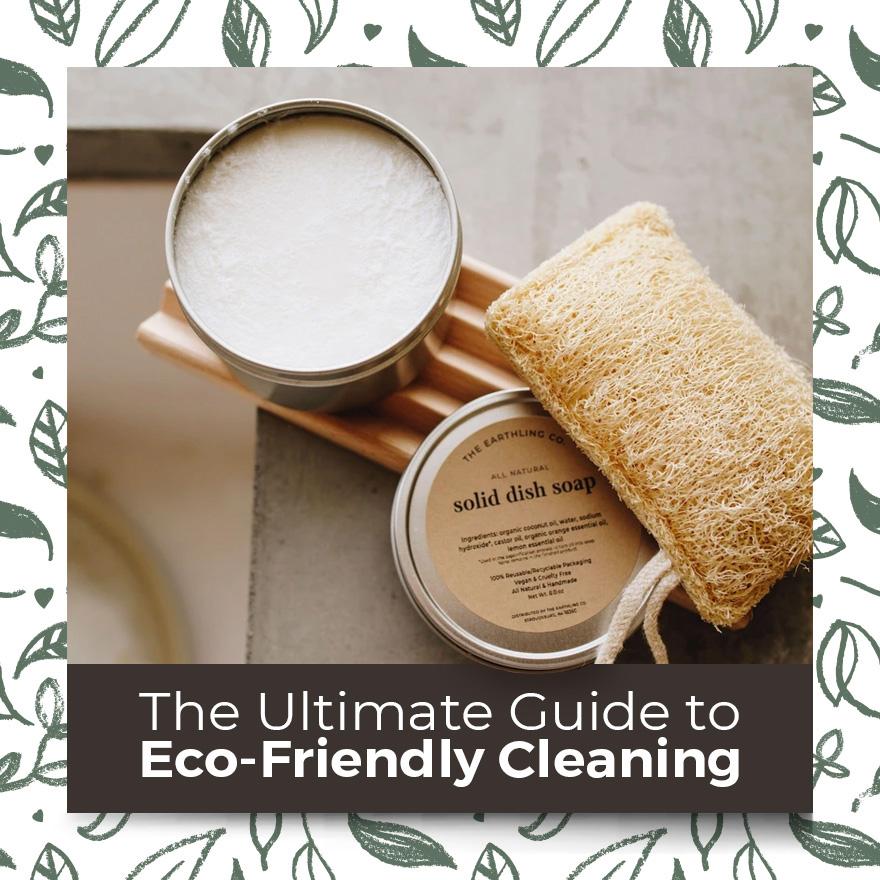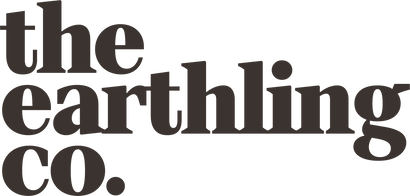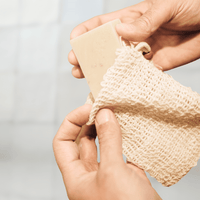
Despite all the spiffing, shining and scrubbing, why is it that our cleaning routines sometimes feel so … dirty? The truth is that the stuff we use to banish dirt and grime is packed with harsh chemicals and compounds that pollute the air, muck up our waterways and even cause allergies and irritation to our family members and pets. Not to mention all the packaging! But there are plenty of ways to switch to an earthling-friendly cleaning routine that contributes to your goal of low-waste living. Read our ultimate guide to green cleaning to give your regular regimen a spruce-up.
Why Your Cleaning Routine Matters
You already know that cleaning products are among the most significant contributors to pollution and global waste. Otherwise, you probably wouldn’t be reading this guide! But how bad is it? Here are the specific ways household cleaning products harm the environment.

- Air Pollution. Household cleaners, paints and perfumes are packed with damaging volatile organic compounds (VOCs) that enter the air and become massive contributors to urban air pollution. These pesky little compounds emit into the atmosphere and react with other chemicals, producing ground-level ozone and airborne particles which can constrict airways and cause heart and lung disease. They also add ozone and fine particulates to the air, resulting in smog.
- Water Pollution. When you rinse your bleach-soaked rags or scrub the bathtub with ammonia, the cleaning solutions travel through the sewage system and eventually wind up in our lakes, rivers and oceans. According to the Environmental Protection Agency (EPA), certain ingredients in your household cleaning products are toxic to aquatic species, including plants and animals. Of course, they also threaten our ability to access clean, potable drinking water.
- Excessive Waste. In order to properly store and transport these chemical-laden cleaning solutions, manufacturers must package them in thick plastic bottles and other packaging materials that are not easily broken down. In fact, it can take up to 500 years for plastic to decompose in landfills! Be sure to choose low-waste cleaning products — such as a dish soap bar instead of a bottle — and prioritize the use of products packaged in more eco-friendly materials.
- Health Hazards. With all this harsh, potentially dangerous stuff in our waterways and air, it’s no surprise that cleaning supplies are to blame for some serious health hazards as well. At best, these compounds can irritate the eyes, lungs and throat. At worst, they can lead to serious health issues, including allergic reactions, chronic respiratory problems and even cancer. Some of these ingredients are also flammable, which poses serious risk to your household and our environment.
Know What to Blacklist
The first step in your quest for green cleaning is to ruthlessly purge. Take an inventory of what’s under the kitchen sink or in your cleaning closet, making sure to get rid of all the items on the list below. Reference our suggested alternatives to keep your space looking spiffy without the worry and waste.

Bleach and Ammonia
Chlorine bleach should be the first thing to add to your cleaning product no-fly list. It’s a harsh, highly irritating and corrosive agent which poses a serious health risk to humans and animals. What’s more, when mixed with certain additives, bleach can produce ultra-fine airborne particles that pollute the air and irritate the eyes, throat, lungs and skin.
Ammonia is another irritating and corrosive household cleaner that can cause serious complications in humans and the environment. Exposure to ammonia can cause burns to the skin, eyes, nose and throat, as well as headaches and coughing. This agent is a major source of nitrogen pollution, causing long-term damage to plants and animals.
When mixed with water, bleach and ammonia can produce dioxins and other harmful chemicals. Unfortunately, these compounds tend to linger and accumulate in our waterways.

What to Use Instead
In place of bleach and ammonia, turn to gentler household cleaners that use gentler, milder cleaning agents. DIY solutions can also serve as excellent bleach stand-ins. In many cases, a mix of gentle dish soap and warm water will do the trick. If you’re looking for a natural bleach alternative that can still bust up caked-on grease and grime, try mixing up your own lemon juice or baking soda cleaning solution. Tea tree oil, castile soap, hydrogen peroxide and distilled white vinegar can also be used as go-to bleach alternatives.
Detergents
Detergents used to clean your clothes and dishes differ from soaps and other cleaners because they contain a combination of chemical compounds. Although they seem harmless, some detergents should be at the top of your blacklist because they are packed with phosphates, which can build up in our waterways and lead to dangerous algae blooms that can starve fish and deprive wildlife of oxygen. They may also contain a sneaky ingredient called alkylphenol ethoxylates, which serves as a surfactant to help cleaning agents properly penetrate. Alkylphenol ethoxylates act as an "endocrine disrupter" in wildlife, causing adverse reproductive effects.
What to Use Instead
As a general rule, try to use “soap” (made with a base, fats and oils) instead of “detergent” (made with chemical compounds) when cleaning your clothes and dishes. Natural cleaners can work just as well as detergents, as they often replace the harsh chemicals of detergents with equally as hard-working natural surfactants such as coconut oil, vegetable glycerin or baking soda. Note that not all types of detergents are bad-- they all have different uses. Do some research and figure out which one works best for your use!
Air Fresheners
It can be nice to use the occasional fragrance to freshen up the air while cleaning, especially in homes with kids and pets. But be careful about what you spray, light or plug into the wall because many of these products are packed with the aforementioned volatile organic compounds, which can contribute to pollution. Before these compounds waft out into the world, they first leave behind indoor pollution inside your home, worsening the air quality for you and your family.

What to Use Instead
Luckily, there are tons of great, natural air fresheners out there that don’t contain anything worrisome or bothersome. If you enjoy burning candles while you clean, make sure to use ones that are made with soy-based wax (not paraffin) and are scented with essential oils. Other natural air freshener ideas include dried florals, essential oil diffusers, essential oil sprays, coffee beans, fresh bouquets and pomander balls. You might also consider investing in some odor-eliminating houseplants that help neutralize bad smells in your house.
Aerosol Sprays
Another seemingly harmless yet surprisingly damaging cleaning supply closet staple is aerosol. Common gas aerosol sprays compress liquids and release a steady stream of mist for cleaning. While these sprays may be convenient, they come at a cost of serious damage to the environment. These sprays emit compounds that contribute to ground-level ozone levels, which can worsen asthma and allergies.
You may know that the government has already banned one of the most harmful elements of aerosol sprays — chlorofluorocarbons or CFCs. But that doesn’t mean aerosol products are suddenly A-OK. In place of CFCs, manufacturers have begun using hydrocarbons and compressed gases such as nitrous oxide, which are greenhouse gases that contribute to global warming and air pollution.
What to Use Instead
You’ll be able to find non-aerosol cleaning products for almost any application, from all-purpose cleaning to air fresheners. Your best bet is to choose bottles that feature mechanical pumps — think: the spray bottles with the little built-in triggers — rather than aerosol mechanisms.
Oven Cleaners
It probably doesn’t surprise you to learn that oven cleaners are packed with harsh, corrosive chemicals. After all, their purpose is to break up the most stubborn baked-on, caked-on grease and grime. To add insult to injury, your typical leave-on oven cleaners tend to be packaged in aerosol spray bottles that double-down on the bad-for-the-earth effect. If you’ve ever used these cleaners, you already know they contain extremely strong ingredients that can instantly irritate the eyes, nose and throat, as well as cause headaches.
What to Use Instead
Who needs harsh oven cleaners when you’ve got a few pantry basics like baking soda and vinegar? You can easily create your own baking soda paste by mixing a half-cup of baking soda with a few tablespoons of water. You’ll want to mix it up until it reaches a paste-like, spreadable consistency. Coat the oven, working the solution into all the nooks and crannies, and let it sit for a few hours or overnight. Using a damp cloth or a natural cleaning brush, scrub away the debris and wipe away any solution that remains. You can then use water or vinegar to spiff and shine.

A Quick List of Bad Words
We know it can be near impossible to tell what’s good and what’s bad for the environment, especially since the government doesn’t require cleaning supply manufacturers to list all of their ingredients. In fact, they are only required to list ingredients made with “chemicals of known concern,” which only scrapes the surface of the list of dangerous additives. With that said, these are some ingredients and words to avoid when shopping for Earthling-friendly cleaning items.

Use Low-Waste Products
In addition to banishing harsh chemical ingredients from your cleaning closet, you’ll also want to blacklist products that contribute excessive waste (especially plastic). Luckily, there are tons of low-waste cleaning products — and even a variety of plastic-free products — that check the slow-to-degrade packaging at the door. Here are some product alternatives to contribute to your quest for low-waste living.
- Soap Bars. Did you know that many cleaning products don’t require any packaging? For example, you can use soap bars to wash your dishes instead of investing in wasteful bottles that will only wind up in the landfill. Side note: The same goes for your bath products. Low-waste shampoo bars are your new best friend!
- Natural Brushes. For as much attention as we pay to cleaning products, it’s just as important to think about your implements. Typical brooms and scrub brushes are made from high-waste, chemical-laden plastic and other materials that are not eco-friendly. Instead, use brushes — such as our natural dish brush and dish scrubber — made with untreated natural materials, like wood and plant fibers.
- Natural Sponges. Just because you’re going green doesn’t mean you have to get rid of convenient daily-use staples like cleaning sponges. Instead, use natural loofah sponges made from 100 percent compostable materials. These products come straight from the Earth and can go straight back to it without leaving behind a trail of waste or damage.
- Refillable Bottles and Natural Concentrates — One of the biggest issues with cleaning products is that we go through so much of them throughout the year. But you can save a ton of waste (and cash) by investing in reusable spray bottles and refilling with a natural cleaning concentrate as you go. These cleaners require only a little bit of liquid to work, meaning one bottle goes a long way.
Pick the Right Partner
The Earthling Co. is your source for the very best low-waste cleaning products and tools. Not only do we offer products designed to minimize damage to our planet, but we also donate a percentage of our sales to organizations that do good for the environment. Browse our entire collection of minimal-waste products to give your routine a squeaky-clean and squeaky-green upgrade!
Image Credits:
Leeyakorn06 / Shutterstock.com
Agafonov Oleg / Shutterstock.com
ZikG / Shutterstock.com
New Africa / Shutterstock.com
Maridav / Shutterstock.com
iiiphevgeniy / Shutterstock.com






